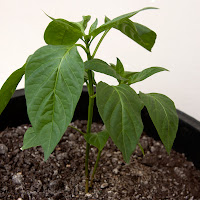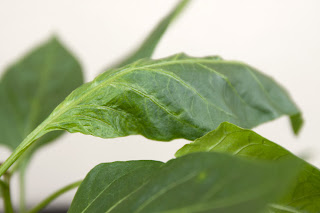An Intro to Bell Peppers
 MY STATUS: Unsuccessful
MY STATUS: Unsuccessful I didn't really put any thought at all into my selection of peppers to grow first. Bell peppers (which Aussie's call capsicum and Pohnpeians call sele) seemed like an obvious choice. I happen to love hot peppers and spicy food in general, having grown up with Northern Mexican cuisine and also lived in South Korea for two years, where hot pepper is used in pretty much everything one consumes. But the kiddies can't handle spicy (yet), so we have to stick to sweet peppers most of the time. I found some California Wonder 300 (TMR) seeds at Home Depot, during a trip to California this winter, and brought them back. The TMR indicates that this cultivar is resistant to Tobacco Mosaic Virus, a pathogen that attacks peppers.
 Bell peppers originate in Central and South America and like warm conditions, but not excessively hot temperatures. The ideal temperature range is 70-84 degrees F, which means temp shouldn't be an issue on Pohnpei. Peppers enjoy moist soil, but won't survive waterlogging. All in all, I don't anticipate they will be particularly difficult to grow here. This is one non-native crop that a lot of locals cultivate successfully. They are even sold in the local markets sometimes, but generally only the green ones. Incidentally, it should be pointed out that red, yellow, orange, and green peppers all come from the same plant; the color merely depends on what point they are picked in the ripening process. Bell peppers will eventually turn red if left on the plant long enough. However, the longer the pepper is unharvested, the more opportunities there are for it to be afflicted by some disease or attacked by a pest. I suppose this is the reason that red bell peppers are more expensive than green bell peppers in the store.
Bell peppers originate in Central and South America and like warm conditions, but not excessively hot temperatures. The ideal temperature range is 70-84 degrees F, which means temp shouldn't be an issue on Pohnpei. Peppers enjoy moist soil, but won't survive waterlogging. All in all, I don't anticipate they will be particularly difficult to grow here. This is one non-native crop that a lot of locals cultivate successfully. They are even sold in the local markets sometimes, but generally only the green ones. Incidentally, it should be pointed out that red, yellow, orange, and green peppers all come from the same plant; the color merely depends on what point they are picked in the ripening process. Bell peppers will eventually turn red if left on the plant long enough. However, the longer the pepper is unharvested, the more opportunities there are for it to be afflicted by some disease or attacked by a pest. I suppose this is the reason that red bell peppers are more expensive than green bell peppers in the store.Speaking of stores, bell peppers are shipped in fairly regularly to Pohnpei's grocery stores, but they tend to be very pricy and sometimes arrive in pretty sorry condition. Sometimes they have slimy skins and black spots or even mold blooming around the stems. There is, then, good reason to grow them yourself.
SHALLOW ROOTS
Pepper plants don't have very extensive root systems, so you don't need super deep pots to grow them. In fact, they don't require much room at all. I've seen bell pepper plants growing wonderfully in really small containers. Of course, the less soil there is to work with, the more fertilizing one will need to do over the life of the plant.
PAIR-BONDING
A strategy I've frequently read about involves planting pepper seedlings in pairs, quite close together (an inch or so). Plants seem to benefit from partnership. They shade each other's fruit with their leaves and lean on each other, requiring less artificial support. The yield for each individual is often twice what it would be if the plants were planted in their own pots.
HARVESTING
Peppers should be ready for harvest about 75 days after seedling transplantation.
What I Did
DAY 1 - SOWING
I used a paper start pot for my peppers, filled it with potting soil, and planted a few seeds. I watered fairly heavily right after planting.DAY 6 - GERMINATION
I see little sprouts (right)!DAY 23 - PLANTING
I probably could have planted my seedlings (left) earlier, but I didn't have the pots or the soil and was busy with other things.SOIL PREPARATION:
I chose some wide shallow pots, since each pot would contain a pair of seedlings. As I always do, I put 2 inches of coarse basalt gravel in the bottom, followed by a layer of black sand. I added a very thin layer of steer manure. I hope this won't be too much; if plants get too much nitrogen early on, they get big and lush, but don't set fruit. In my case, the fertilizer is way down in the bottom, and I think the plants will be quite large and near mature before their roots get that deep. The soil mixture was pretty normal--a balanced mixture of store-bought garden soil and Miracle Grow Potting Mix.
DAY 24 - WHITEFLIES SIGHTED
I found two whiteflies on the underside of the leaves of one of the plants (right). This is alarming, because I remember what unchecked whiteflies did to two chili pepper plants we had about a year ago. I bought a bottle of Insecticidal Soap Spray specifically for whiteflies and gave the peppers (and my tomato plants) a good spritz bottom to top. I'm also looking into making some sticky traps and trying a garlic solution.DAY 26
I'm still finding an occasionally whitefly here and there, but I killed them and washed the leaves of their honeydew. The paired pepper plants are about 3 inches tall now with large healthy leaves.DAY 51
There isn't much to report. My plants are healthy, but growing slowly. They are fairly sensitive to hot sun, so I have kept them in partial shade except early in the morning. Whiteflies continue to appear here and there, but the plants are not infested and seem unaffected by the few pests that are there. I think I'll fertilize on the next watering. I probably could have planted in pots with a smaller circumference.DAY 82 - STRUGGLING
Additionally, I sowed some new seeds in starter pots. If things continue not to go well, I can start over.
DAY 98 - TERMINATION
Even with more sunlight, these little guys didn't improve. The leaves continued to get stiff and curled in, indicating that something was wrong, and the plants stayed small and didn't flower. I never figured out what was wrong exactly. They didn't resemble any of the photos of diseased pepper plants I looked at. It's possible this is the result of a virus transmitted by the whiteflies.I decided to pull the plants up and start over with new seedlings. One thing I learned for sure on this first run: I my pots were way too large. On the second run I'll stick to small pots.












.jpg)







0 comments:
Post a Comment